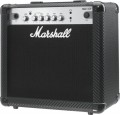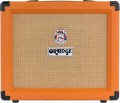Power
Rated power of the device.
Let us recall that in acoustics the rated power is the highest average (root mean square) power of a sound or signal that a device can produce for an indefinitely long time. Individual volume jumps can be several times higher than this indicator, but the key characteristic is the average value. But the specific meaning of this parameter depends on the type of equipment (see above). So, for combo amplifiers, this paragraph usually gives the power of the built-in speakers; The capabilities of your own amplifier, by definition, correspond to this figure, so for such equipment the rated power determines solely the overall sound volume. The power of the acoustics is also indicated for cabinets, but here another point becomes relevant - compatibility with an external amplifier (primarily the “head”). The output power of this amplifier should not be higher than the rated power of the cabinet to avoid overloads; and ideally, these characteristics should match - this will allow you to use the speaker at full power without sound distortion.
For the head, accordingly, this paragraph provides the rated output power, which determines the ability of the amplifier to operate with a specific cabinet or other speakers. However, it is worth noting that the maximum possible power value is indicated as the nominal value for heads, which is not always achieved. Thus, many models provide several sound outputs - for passive acoustics with different...impedances (remember, standard impedance values are 2, 4, 8 and 16 Ohms); and the higher the impedance of the connected speaker, the lower the actual power will be. Other heads have the ability to limit the maximum power - for example, so that at the maximum level the device produces not 100 W, but 50 W or even 25 W. Sometimes these features are combined in one device.
In any case, when choosing according to this indicator, it is worth taking into account the features of the planned use of the equipment. For example, it hardly makes sense to purchase even a 40-watt “combination” for practicing at home - for these purposes 15 watts, or even less, will be quite enough. And if we are talking about a tube device, then in our example the maximum recommended power will be only 5 W - the specificity of tube circuits is such that with the same rated power they are more effective than transistor ones in terms of audibility. For rehearsals in a group without a drum kit (for example, two guitars plus a bass), a higher power is desirable, about 40 “transistor” watts, and if there are drums, at least 60 watts. Transistor devices with a power of up to 150 W and tube devices with a power of up to 40 - 50 W are suitable for specialized rep bases and concerts in relatively small rooms, and higher figures are found mainly in equipment for large-scale events. Detailed recommendations regarding optimal power for certain conditions can be found in special sources.
It is worth mentioning bass amplifiers separately: it is believed that for normal coordination with each other, the power of a bass “combination” should be twice as high as the power of a guitar one.
Number of channels
The number of channels provided in a combo amplifier or a separate “head” (see “Type”).
This parameter is specified only if the device has
more than one channel. The channel in this case can be described as a kind of “path” for the audio signal, which has its own specific set of settings. If there are several such “paths,” then each of them can be configured at your discretion and you can switch between sound options with just one click of a button (in extreme cases, by switching the instrument to another input). The most typical example of using this function looks like this: one channel is used for clean sound, and the second is used for “overdrive” using the built-in distortion or overdrive (see “Effects”). Without channel separation, the sound would have to be changed either by reconfiguring the amplifier (setting the parameters again each time, which is simply inconvenient), or by using external “gadgets” (and this is not always the best option for a number of other reasons).
As for the number of channels, in multi-channel models there are most often just two of them - this gives the mentioned additional capabilities and at the same time does not particularly affect the cost of the device. This option is optimal for beginning musicians, but is also found in professional equipment. Increasing the number of channels makes it possible to provide more advanced options for preset settings (for example, “clean ringing”
..., “clean warm”, “Crunch” and “Overdrive”), but it significantly complicates and increases the cost of the design. Therefore, the higher this number, the fewer models with such characteristics are presented on the market. The maximum value found in modern guitar amplifiers is 6; a similar amount can be found in individual professional models, mainly with a digital element base (see “Type”).Headphones
The type
of headphone output provided in the design of the amplifier.
Headphones will be useful especially in a situation where you can not make noise — for example, when practicing the guitar at a late time. And the options for their connection can be as follows:
— Mini-Jack (3.5 mm). Output for a standard 3.5 mm mini-Jack plug. This plug is equipped with most modern headphones, especially entry-level and mid-range. However, in terms of the quality and reliability of the connection, it is noticeably inferior to the larger Jack 6.35 mm (see below), so it is relatively rare in combo amplifiers.
— Jack (6.35 mm). The connector is quite large, designed mainly for stationary audio equipment. As the main connection method, it is rarely found among headphones, these are mainly professional models. At the same time, you can connect headphones with a 3.5 mm mini-Jack connector to such a jack using a simple adapter (in many “ears” such adapters are even included in the standard package); and the connection itself is tight, reliable and with a minimum of interference from the point of contact. Due to this, most "amps" use this type of connector.

